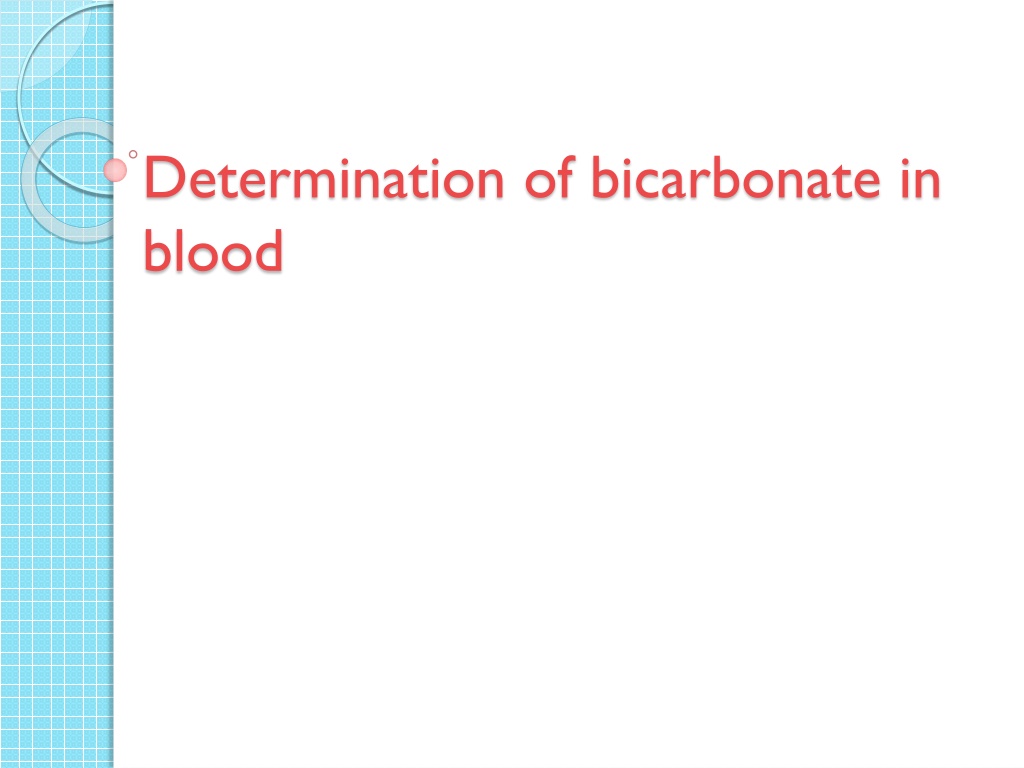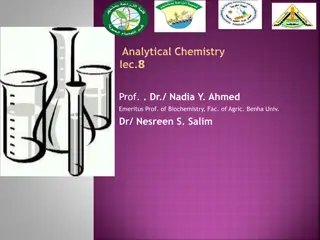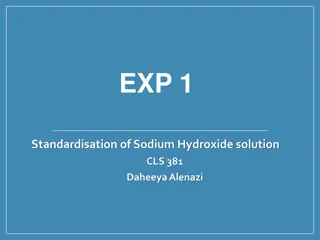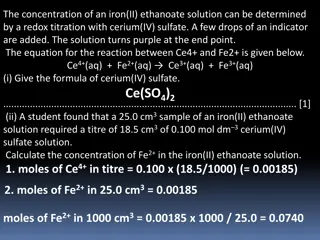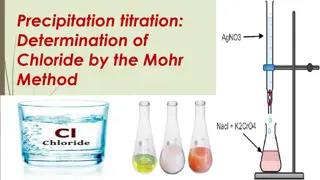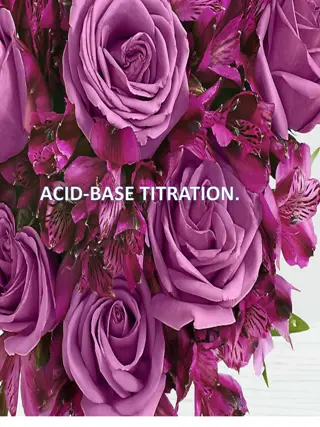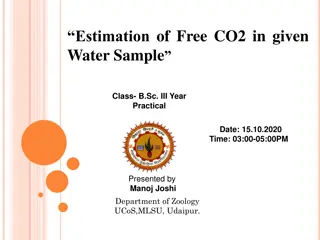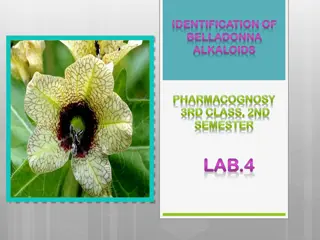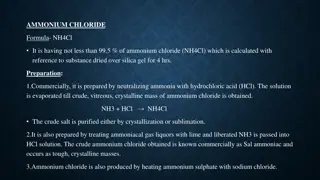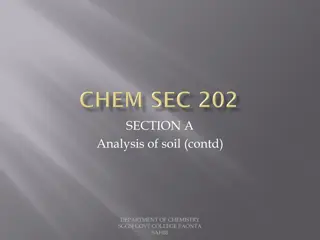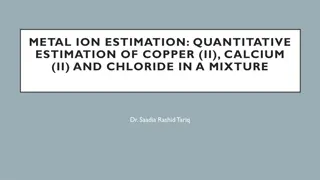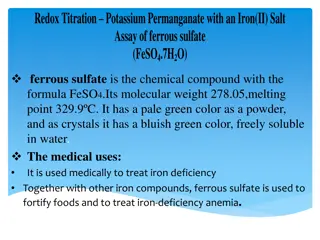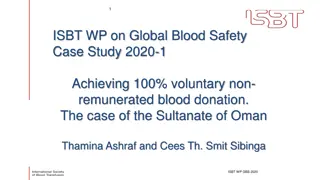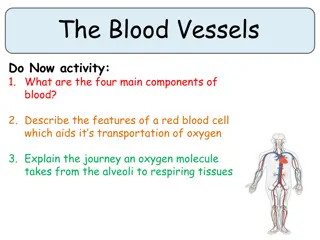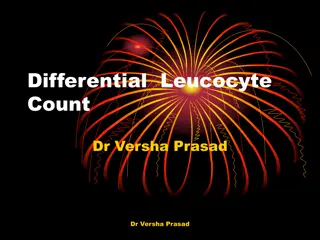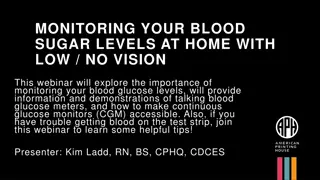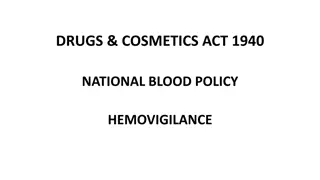Determination of Bicarbonate in Blood Using Back Titration
Back titration is an analytical chemistry technique used to determine the concentration of an analyte, such as bicarbonate in blood. This method involves reacting the analyte with an excess reagent, followed by back-titrating the remaining excess and relating it to the original sample's concentration. The process is advantageous in cases where direct titration is challenging due to factors like impurities or slow reaction rates. However, it requires skill and proper instrument calibration. In the case of determining bicarbonate concentration in blood, excess HCl is added to volatilize bicarbonate as CO2, which is then back-titrated with NaOH to determine the bicarbonate level.
Download Presentation

Please find below an Image/Link to download the presentation.
The content on the website is provided AS IS for your information and personal use only. It may not be sold, licensed, or shared on other websites without obtaining consent from the author. Download presentation by click this link. If you encounter any issues during the download, it is possible that the publisher has removed the file from their server.
E N D
Presentation Transcript
Back titration is an analytical chemistry technique that allows the user to Determine the concentration of an analyte by reacting it with a known number of moles of excess reagent. The excess reagent is then titrated with a second reagent. The concentration of the analyte in the original solution is then related to the amount of reagent consumed.
purposes of using back titration Back titration is designed to resolve some of the problems encountered with forward or direct titration. Possible reasons for devising back titration technique are : 1- The analyte may be in solid form . 2- The analyte may contain impurities which may interfere with direct titration. 3- The analyte reacts slowly with titrant in direct or forward titration. 4- Weak acid weak base reactions can be subjected to back titration for analysis of solution of unknown concentration.
Advantages of doing back titration 1- Useful if the endpoint of the reverse titration is easier to endpoint of the normal titration. 2- Useful when trying to work out the amount of an acid or base in a non-soluble solid. identify than the
Disadvantages of back titration 1- Needs skill and practice for effective results 2- Instruments have to be properly calibrated since it will give affected the final result. 3- Reactivity of the elements to be titrated should be well researched since this may affect the end point. 4- Time consuming if done manually.
Principle The HCO3 concentration is determined by : 1- Adding an excess of 0.001M HCL, to volatilize the HCO3 ( Weak Base) as CO2, swirling to allow the CO2 to escape. 2- Back-titrating the excess HCL (strong Acid) with 0.001M NaOH (Strong Base).
Principle HCO3 + excess HCL H2O + CO2 + CL Excess HCL + NaOH NaCL + H2O ( back titration)
Procedure A) Comparison Solution: 1- In Erlenmeyer flask mix the following: 6 ml 1% saline 0.1 ml sample (NaHCO3) 2 drops phenol red Important (Shake after each addition). 2- rotate gently to mix the contents until get pink color (end point) . N.B.: if you use blood sample , the transition range of this indicator is pH 8.4-6.7 (yellow to red).
B) Titration of the Sample : A) First reaction: 1- In Erlenmeyer flask mix the following: 4 ml 1% saline . 0.1 ml sample (NaHCO3). 10 ml HCL (0.001 M) (excess) 2- Shake after each addition to allow the (CO2) to escape. 3- add 2 drops phenol red .
B) Second reaction: 1) Titrate with NaOH (0.001 M) until you get pink color (end point). 2) Record the volume used.
Calculation 1- HCO3- = {(M= ?) , (V=0.1 ml)}. HCO3- + Excess HCL (known molarity,known volume) H2O + CO2 + CL- . Remember ! Weak Base + acid = No great pH = hard to detect end point. HCO3- + ( Excess HCL = strong acid) titrated with NaOH (strong base) = sharp end point .
How to work out HCO3- Concentration? HCL + NaOH NaCL + H2O 0.001 M 0.001 M ml = ? 7 ml Number of moles of NaoH = Number of moles of Hcl C HclX VHcl= C NaOHX V NaOH VHcl = (0.001X7)/ 0.001 = 7 ml.
HCL (Supplied) HCL (Left over) = HCL (reacted). 10 ml 7 ml = 3 ml reacted with HCO3-. HCO3- + HCL H2O + CO2 +CL-. = 0.1 ml, ? M + 3 ml , 0.001 M. Number of moles of HCO3-= Number of moles of Hcl C HCO3 X VHCO3= C HclX V Hcl C HCO3 = 0.001 X 3/0.1=0.03 M
